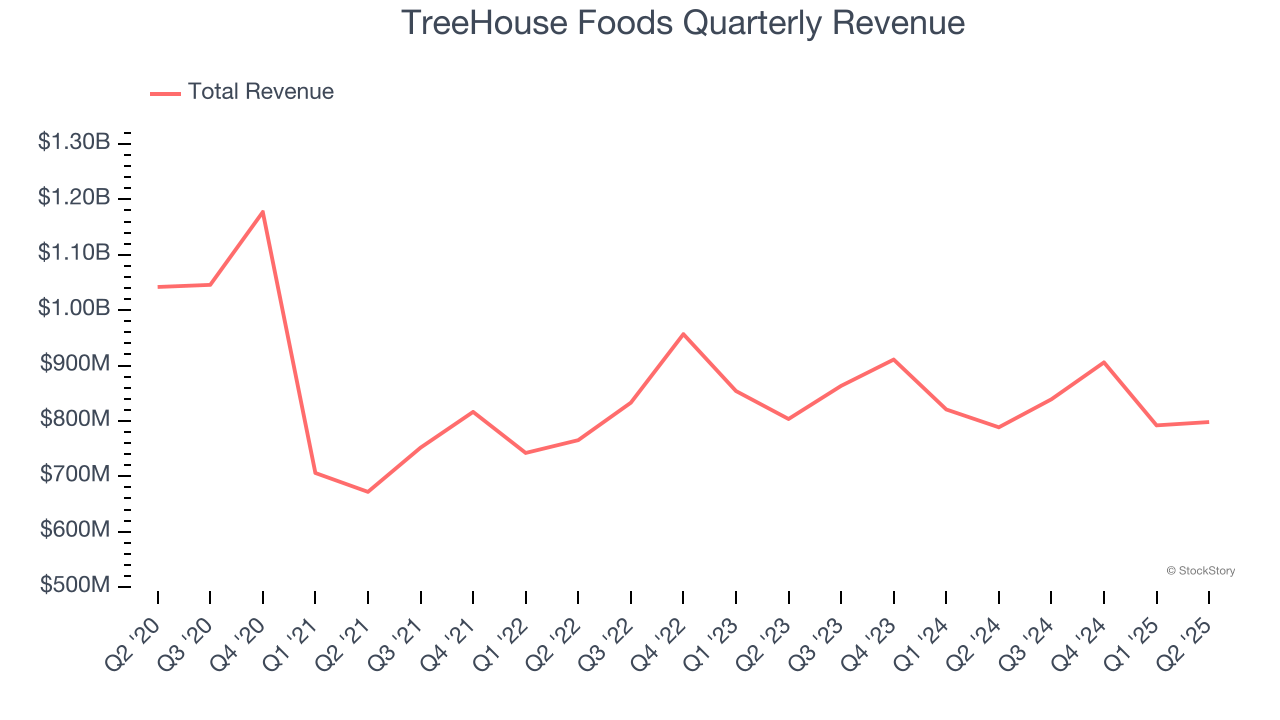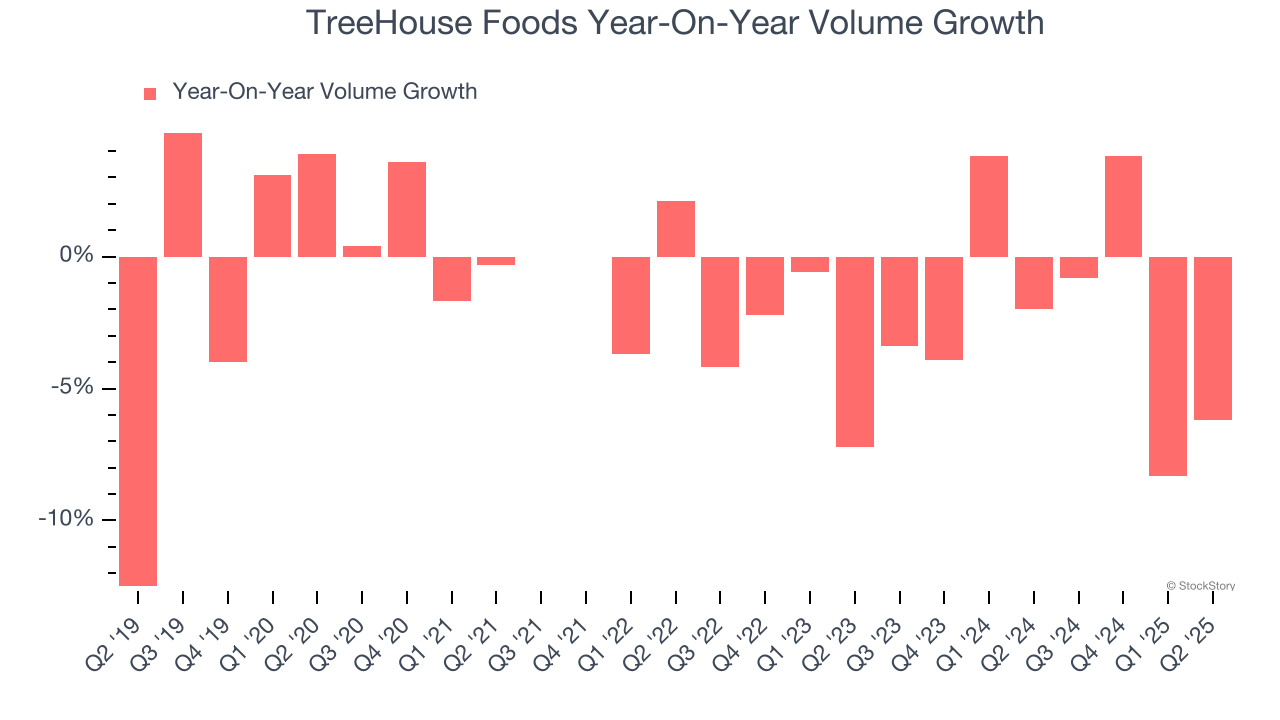
Private label food company TreeHouse Foods (NYSE: THS) announced better-than-expected revenue in Q2 CY2025, with sales up 1.2% year on year to $798 million. The company expects next quarter’s revenue to be around $855 million, close to analysts’ estimates. Its non-GAAP profit of $0.17 per share was 47.1% above analysts’ consensus estimates.
Is now the time to buy TreeHouse Foods? Find out by accessing our full research report, it’s free.
TreeHouse Foods (THS) Q2 CY2025 Highlights:
- Revenue: $798 million vs analyst estimates of $787.7 million (1.2% year-on-year growth, 1.3% beat)
- Adjusted EPS: $0.17 vs analyst estimates of $0.12 (47.1% beat)
- Adjusted EBITDA: $73.3 million vs analyst estimates of $65.94 million (9.2% margin, 11.2% beat)
- The company slightly lifted its revenue guidance for the full year to $3.39 billion at the midpoint from $3.37 billion
- EBITDA guidance for the full year is $360 million at the midpoint, above analyst estimates of $356.3 million
- Operating Margin: 3.4%, up from -0.5% in the same quarter last year
- Free Cash Flow was -$70.5 million compared to -$42.2 million in the same quarter last year
- Organic Revenue fell 2% year on year (-5% in the same quarter last year)
- Sales Volumes fell 6.2% year on year (-2% in the same quarter last year)
- Market Capitalization: $1.04 billion
Company Overview
Whether it be packaged crackers, broths, or beverages, Treehouse Foods (NYSE: THS) produces a wide range of private-label foods for grocery and food service customers.
Revenue Growth
Reviewing a company’s long-term sales performance reveals insights into its quality. Any business can put up a good quarter or two, but the best consistently grow over the long haul.
With $3.33 billion in revenue over the past 12 months, TreeHouse Foods carries some recognizable products but is a mid-sized consumer staples company. Its size could bring disadvantages compared to larger competitors benefiting from better brand awareness and economies of scale.
As you can see below, TreeHouse Foods grew its sales at a sluggish 2.7% compounded annual growth rate over the last three years as consumers bought less of its products. We’ll explore what this means in the "Volume Growth" section.

This quarter, TreeHouse Foods reported modest year-on-year revenue growth of 1.2% but beat Wall Street’s estimates by 1.3%. Company management is currently guiding for a 1.9% year-on-year increase in sales next quarter.
Looking further ahead, sell-side analysts expect revenue to grow 1.7% over the next 12 months, similar to its three-year rate. This projection is underwhelming and suggests its products will face some demand challenges.
Unless you’ve been living under a rock, it should be obvious by now that generative AI is going to have a huge impact on how large corporations do business. While Nvidia and AMD are trading close to all-time highs, we prefer a lesser-known (but still profitable) stock benefiting from the rise of AI. Click here to access our free report one of our favorites growth stories.
Volume Growth
Revenue growth can be broken down into changes in price and volume (the number of units sold). While both are important, volume is the lifeblood of a successful staples business as there’s a ceiling to what consumers will pay for everyday goods; they can always trade down to non-branded products if the branded versions are too expensive.
To analyze whether TreeHouse Foods generated its growth (or lack thereof) from changes in price or volume, we can compare its volume growth to its organic revenue growth, which excludes non-fundamental impacts on company financials like mergers and currency fluctuations.
Over the last two years, TreeHouse Foods’s average quarterly volumes have shrunk by 2.1%. This isn’t ideal for a consumer staples company, where demand is typically stable. When a company discounts its products, customers typically buy more (especially in a stable sector like consumer staples). That wasn’t the case for TreeHouse Foods, and therefore, it’s implied that consumers don’t value its products. Investors should steer clear of the company until things change.

In TreeHouse Foods’s Q2 2025, sales volumes dropped 6.2% year on year. This result represents a further deceleration from its historical levels, showing the business is struggling to move its products.
Key Takeaways from TreeHouse Foods’s Q2 Results
We were impressed by how significantly TreeHouse Foods blew past analysts’ EPS and EBITDA expectations this quarter. We were also excited its revenue outperformed Wall Street’s estimates and that it lifted its full-year guidance. Overall, we think this was a solid quarter with some key areas of upside. The stock remained flat at $20.57 immediately after reporting.
Is TreeHouse Foods an attractive investment opportunity at the current price? We think that the latest quarter is only one piece of the longer-term business quality puzzle. Quality, when combined with valuation, can help determine if the stock is a buy. We cover that in our actionable full research report which you can read here, it’s free.





